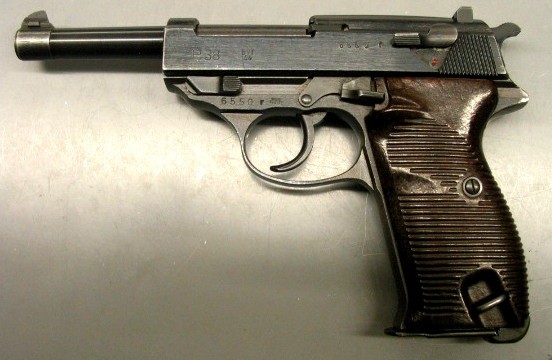There are at least three things that have carried the moniker "P-38". And in some cosmic convergence or bizarre coincidence, all three were unprecedented design breakthroughs. Two were seminal enough to remain in use for the better part of a century, while the other had a much briefer production life, but defined a path from the past to the future that influenced similar designs for decades to come. Whether there is some magic in the 'P-38' designation, or it's all just a tremendous triple-coincidence, you can assume that anything called P-38 is very likely very good at whatever it does.
And in the case of the P-38, the coincidence is even more remarkable because all three iconic P-38s were developed within five years of each other. Here, in approximate chronological order, are the P-38s that changed the world:
The Lockheed P-38 Lightning
.jpg) |
| The Fork-Tailed Devil |
The P-38 was the only American fighter that was in production every day of the war, with more than 1800 still on order that were cancelled when the war ended. The top two American aces of the war, Richard Bong and Tommy McGuire, both flew P-38s in the South Pacific. It was a P-38 piloted by Rex Barber that shot down the Japanese bomber carrying Admiral Isoroku Yamamoto, killing him.
The P-38 served with the US until 1949, rendered obsolete by the jet age. But in its time it was a necessary part of the US arsenal - a heavy, fast, reliable, powerful fighter to complement its smaller, more nimble brethren.
The Walther P-38
 |
| A VERY good gun |
The P-38 was a true breakthrough in automatic pistol design. It can be fairly regarded as the first 'modern' handgun. The major breakthrough was the DA/SA design that would ultimately become the default for modern autos with the advent of the 'Wondernine' in the early 1980s. This feature allowed the gun to be carried with a round in the chamber and the hammer 'decocked'. A single long-stroke pull of the trigger allowed the gun to be cocked and fired (DA, or Double Action), with subsequent rounds being fired with the hammer automatically cocked by the cycling of the action (SA, or Single Action). The P-38 also included a visual/tactile loaded chamber indicator, a small metal post that would pop up above the surface of the slide when a round was in the chamber. Even in total darkness, you could know for certain whether the gun was ready to fire.
The venerable Walther design is still available today. It has been produced by manufacturers in dozens of countries. I have owned two, a Walther and a Spanish Manhurin version. They are accurate, dependable and easy to shoot well. They are small and light for a service pistol - I often just stuffed mine in the back pocket of my jeans. Some of the early Walthers are collectable, but so many were made, and made so well, that they are still shooters today. Alongside the classic 1911 and K frame revolver designs, the P-38 is an iconic and very long lived 20th century handgun design.
The P-38 Can Opener
 |
| You always kept one on the chain with your dogtags |
In the early months of 1942, America found itself at war on both sides of the globe. The 'Arsenal of Democracy' needed lots of almost everything - uniforms, weapons, trucks, planes, explosives - and food. Food that could be preserved and shipped around the world, in packaging that would stand up to life on the march, and on the battlefield, in all kinds of conditions. In terms of the technology of the time, that meant sealed in steel cans. And that meant that there had to be a way to ensure that every GI, no matter where he might be, could open those cans. The obvious solution - include a can opener with every meal - seemed impractical at first, but when the C-Ration units were shipped in 1940, they came with an accessory pack that included, along with sugar, gum, cigarettes and toilet paper, an ingenious tiny folding can opener called the P-38. GIs immediately developed the habit of keeping one on the chain with their dogtags where it was readily available.
The mighty little can opener is a classic of industrial design. Simple, foolproof and a perfect solution to a specific problem, the P-38 was ubiquitous in war zones and disaster areas - anywhere there were C-Rations, there were P-38 openers - right up through the Vietnam war. Modern food preservation and packaging techniques have lead to the MRE and the elimination of the steel can, but even today, campers and backpackers happily go into the wilderness with a couple of P-38s in their gear.
Why is it called P-38? Well, some have said that it's because it measures 38mm in length - which it does - but that seems unlikely as very few Americans had any familiarity with the metric system in 1942. The most common explanation is that, on average, it took 38 twists of the opener to open a standard ration can.
...
This comment has been removed by the author.
ReplyDeleteI'll be damned (For many reasons.) but I've never heard of the P-38 can opener. (Never camped w/ cans.)
ReplyDeleteOn the other hand, I know someone who still has the Walther P-38 his father liberated from a Kraut officer during the proverbial big one 70+ yrs. ago.
And the Lightning (spell check is not your friend) is about as classic as they get.